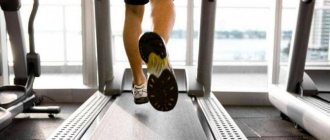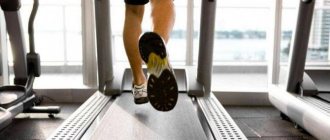If you want to quickly burn fat (not muscle), without long grueling cardio sessions, then we suggest you learn more about what high-intensity interval training (HIIT) is. You may have already heard about it and its almost magical ability to burn fat. That you can exercise just a few minutes a day and watch the fat melt away right before your eyes. Actually this is not true. High-intensity interval training (HIIT) is not the only tool for burning fat reserves, but if used correctly, HIIT can be a powerful tool in the fight against excess weight. And we will talk about this in this article.
Content
- 1 Intensity of physical activity
- 2 Intensity of training in bodybuilding (mass gain)
- 3 Intensity of fitness training (fat burning)
- 4 Intensity and volume of strength training
- 5 Special techniques for increasing training intensity 5.1 Short rest breaks
- 5.2 Increasing the number of repetitions
- 5.3 Increasing training weight, working on strength
- 5.4 Speed training
- 5.5 Complex sets and circuit training
- 5.6 Supersets
- 5.7 Forced reps
- 5.8 Negative repetitions
- 5.9 Step sets
Low load IIT for freshers
This fat-burning interval workout is for you if you want to start at home at a lower intensity level. There are no jumps, so it will help you get into the swing and then move on to moderate-intensity activities.
Necessary equipment
Medicine ball (2-5 kg)
Lesson scheme:
- Do at least 5 minutes of warm-up cardio.
- Perform each exercise for up to 60 seconds.
- Increase the load by using a heavier medicine ball, a wider range of motion, or, if desired, adding a jump to the exercises.
Rest longer if you feel too uncomfortable.
| Time | Exercise | ShVN |
| 5 minutes | Warm-up | Warm up to level 5 |
| 1 min |
| Complete to level -8 |
| 30 sec | Swinging your arms or walking in place | Level 5 |
| 1 min |
| Level 6-7 |
| 30 sec | Swinging your arms or walking in place | Level 5 |
| 1 min |
| Level 7 |
| 30 sec | Swinging your arms or walking in place | Level 5 |
| 1 min |
| Level 7-8 |
| 30 sec | Swinging your arms or walking in place | Level 5 |
| 1 min |
| Level 8 |
| 30 sec | Swinging your arms or walking in place | Level 5 |
| 1 min |
| Level 8 |
| 30 sec | Swinging your arms or walking in place | Level 5 |
| 1 min |
| Level 8 |
| 30 sec | Swinging your arms or walking in place | Level 5 |
| 1 min |
| Level 8 |
| 30 sec | Swinging your arms or walking in place | Level 5 |
| 1 min |
| Level 8 |
| 5 minutes | Walk slowly to cool down | Level 4 |
Lesson time: 23 minutes
Bodybuilding training intensity (mass gain)
The overall intensity of a bodybuilding workout may vary from week to week to eliminate muscle adaptation to the load and maintain muscle growth. This principle is called periodization. To obtain maximum results, it is recommended to vary the training intensity according to the following scheme:
- FIRST WEEK
: High intensity - SECOND WEEK
: Medium intensity - WEEK THREE
: Very high intensity - WEEK FOUR
: Low intensity
One of the most common mistakes the average weightlifter makes in bodybuilding is that you set your training intensity so that it ends up being more or less the same every week. A much more effective strategy is to vary the intensity of your physical activity each week, with the goal of strengthening your body in the long term and allowing for faster muscle growth. Reducing your load each week (and especially with this program, every fourth week) allows you to train more intensely during all the intervening weeks than you would likely be able to train if you were trying harder. We must remember the saying that “fatigue masks physical fitness.” The fact that you cannot perform an action at a certain moment (namely when you are very tired) does not mean that you will not be able to perform it under other circumstances (ie when you are rested and have a clearer mind). psychological motivational stimulus).
By having lower-load weeks, you can give your muscles more opportunity to adapt to the stresses imposed during the weeks you trained harder than you would have if you had kept the load at the same, higher level. . The entire process of training in bodybuilding is associated with the development of a stimulus and adaptation to loads, but both cannot occur at the same time; these phenomena occur sequentially. Hard training creates the prerequisites for the body to adapt to the loads in the presence of a stimulus. A lighter version of consistent training simplifies the process of adapting to stress and prepares the body to be ready to perceive greater stimuli.
Finally, muscle strength will typically increase maximally at the end of the lower-impact week and at the beginning of the week following it. These moments in the training process will give you the opportunity to make the most of the skills you acquired through your last training and recovery. Nothing stimulates adaptation to future stress more than training in which you perform at your best.
What it is
HIIT is an English acronym that stands for High-intensity interval training. And the mysterious word immediately turns out to be a well-known type of sports activity. HIIT training is a high-intensity interval training that involves alternating intense but short-term training phases and less physically intensive recovery periods.
The most striking example of HIIT training is sprinting. Athletes alternate between a 15-second run at their body's maximum strength and capacity with a 45-second walk at a slow pace (some simply stand or do light recovery exercises during this time). The duration of the entire training is 15 minutes.
Since Finnish runners showed excellent results at the beginning of the 20th century by practicing HIIT training in the preparatory stage for competitions, other track and field athletes have become interested in them. 4-time Olympic champion Emil Zatopek and 2-time Olympic champion Vladimir Kuts confirmed their high effectiveness.
The scientific justification did not take long to arrive. The English physiologist Archibald Vivien Hill proved that it is high-intensity interval training that promotes the fastest fat burning, while pumping up muscles. For his description of the thermodynamics of muscle activity, the scientist was awarded the Nobel Prize in Physiology or Medicine in 1922.
So, despite the fact that HIIT training is now a trend, it was introduced into practice and scientifically proven 100 years ago.
Fitness training intensity (fat burning)
The term "intensity" has a few different meanings depending on the type of exercise you perform, but generally describes how hard you work during a workout. The intensity of aerobic fitness exercise can be assessed by measuring your heart rate (Calculating your optimal heart rate). The latter shows how much work your heart does to support a certain activity, including fitness exercises.
To achieve optimal fat burning rates, you should exercise at such an intensity that your heart is working at 70-85% of its capacity. The level of the latter can be calculated using the formula: 220 minus your age. During low-intensity exercise—20 minutes or longer at approximately 50% of the heart's maximum capacity—fat stores provide up to 90% of the energy. And during aerobic exercise with a cardiac load of about 75%, less fat is burned (about 60%), but the body loses more total calories, including “fat” ones.
As an example, I can cite comparative data based on studying the intensity of aerobic training. If you push your heart to 50% of its maximum capacity, you burn 7 calories per minute, 90% of which are fat. At a load of 75%, 14 calories are burned per minute, of which 60% are fat. Thus, in the first case you burn only 6.3 “fat” calories per minute (0.9 x 7 calories), and in the second you burn at least 8.4 (0.6 x 14 calories). That is, with higher training intensity, you burn more fat calories.
If you find it difficult to exercise at a high level of efficiency, try increasing the duration of your workout - then you can burn the same amount of fat as if you exercised more intensely, but for less time.
To increase your fat burning rate, gradually increase the duration of your aerobic activity from 30 to 60 minutes. Or cover longer distances. For example, running 1.5 km on a track will burn about 100 calories. Run 8 and you'll burn 500.
Another factor related to how long you exercise is how often you exercise: the more often you exercise, the more calories you will burn. Perhaps for variety and to burn more calories, you will want to add cycling aerobics, cardio training using a step platform, kickboxing or dance aerobics to your main classes.
The intensity of strength training depends on how much weight you can lift. In order for your muscles to become more active—to become stronger and develop better—you need to try giving them more physical activity. This means constantly increasing the demands (compared to what they are used to) and steadily increasing the weight they lift - from session to session. The more muscle mass you build, the more efficient your body will be at burning fat. After all, muscles are the most metabolically active tissue in the body.
IIT Basics
While IITs are designed to push the boundaries of your capabilities, this fat-burning workout at home or at the gym will take you far beyond your comfort zone for a period of time. When making an IIT plan, you need to focus on four important things: duration, intensity, frequency and length of the recovery interval.
In general, an exercise interval should last between 5 seconds and 8 minutes at an intensity that is 80 to 95 percent of your maximum heart rate if you are using that as a guide, or 9 to 10 on the Perceived Exertion Scale (PES). that is, subjectively felt tension.
The rest time between intervals depends on your fitness level and goals.
If you're already quite advanced, you can try a 2:1 work-to-rest ratio. This means that the rest is shorter than the working set, meaning after a 1 minute sprint you rest for 30 seconds.
For a less intense workout, you can take a 1:2 ratio, that is, you work out for 30 seconds and then rest for 1 minute.
Or you can make work intervals the same as rest intervals.
With that in mind, here are 5 different fat-burning interval workouts that are suitable for anyone. But before you start, there are a few things to keep in mind.
Intensity and volume of strength training
Source:
“Bodybuilding.
Book trainer" .
Editor:
Oksana Usoltseva
Ed.
: Eksmo 2013
Main article:
volume of physical activity
To monitor well-being, plan and analyze training activities in modern fitness, as in other sports, several formulas and systems are used.
The intensity and volume of strength training will help you judge the results more objectively, control your training, and avoid overtraining. Simply put, it’s a good idea to know what average weight you trained with and how much you lifted during the entire workout.
For example, you perform several physical exercises, including squats with a barbell. Let's say that in the first two warm-up sets the weight of the barbell is 60 kg, with which you perform 12 repetitions.
In the next, third approach, you squat 10 times, but with a weight of 80 kg. In the fourth set - 100 kg in 8 repetitions.
And the fifth set - 120 kg for 6 reps. We calculate, starting from the first set: 60 kg multiplied by the number of repetitions in the set, that is, by 12. We get 720 kg. Since there were two such approaches, we multiply 720 by 2.
We do the same with all subsequent sets: 80 x 10 = 800; 100 × 8 = 800; 120 x 6 = 720. Let’s sum up the numbers: 1440 I 800 1 800 + 720 = 3760 kg. The result obtained is the volume of training (squats).
To calculate the intensity (average weight) for this exercise, you need to divide the volume by the number of repetitions in all sets: 3760/(12 + 12 + 10+ 8+ 6) = 78 kg. Thus, your intensity in the barbell squats is 78 kg. By making similar calculations for all exercises, you will know the total volume of the workout and its intensity. The obtained figures will help control the systematic increase in load in a weekly or other cycle, as well as establish the causes of overtraining.
Group HIIT workouts for intermediate levels
HIIT workout for arms and shoulders (20 minutes)
Aerobic strength training with an emphasis on arms and shoulders. The program contains 4 circles with 6 exercises in each circle: 25 seconds work and 15 seconds rest (for the first, third and fifth exercise), 40 seconds work and 20 seconds rest (for the second, fourth and sixth exercise). You will need dumbbells.
- Jumping Jack
- Overhead Press
- Full Plank with Shoulder Tap
- Side to Side Hop
- Asymmetrical Push up on Knees
- Bicep Curl
FITNESS EQUIPMENT: detailed review
Full body HIIT strength workout (22 minutes)
Strength training for the upper and lower body. The program contains 3 circles of 5 exercises in each circle: 60 seconds work and 30 seconds rest. You will need dumbbells.
- Weighted Squat with Calf Raise
- Lunge with Bicep Curl
- Weighted Deadlift
- Lateral Raise
- Hammer Curl
HIIT workout for buttocks and legs (22 minutes)
Aerobic strength training with emphasis on the buttocks, legs and inner thighs. The program contains 3 circles of 5 exercises in each circle: 60 seconds work and 30 seconds rest. You will need dumbbells.
- Jump Squat
- Side Lunge
- Weighted Sumo Squat
- Ice Skater
- Low Sprinter Lunge
TOP 30 best cardio exercises
HIIT workout for buttocks (22 minutes)
Aerobic strength training with an emphasis on the buttocks. The program contains 4 circles with 6 exercises in each circle: 20 seconds work and 30 seconds rest (for the first, third and fifth exercise), 40 seconds work and 20 seconds rest (for the second, fourth and sixth exercise). You will need dumbbells.
- Vertical Jump
- Jump Lunge
- Side to Side Hop
- Squat Press
- Burpee
- Weighted Sumo Squat
Full body HIIT workout (24 minutes)
Aerobic strength training for the whole body. The program contains 4 circles of 6 exercises in each circle: 30 seconds work, 10 seconds rest (for the first and fourth exercises), 40 seconds work, 10 seconds rest (for the second and fifth exercises), 60 seconds work, 30 seconds rest (for the third and sixth exercise). You will need dumbbells.
- Pencil Jack
- Overhead Lunge
- Push-up with Side Plank
- Jump Lunge
- Weighted Burpee
- Squat, Curl, Press
Top 20 women's SNEAKERS for fitness
HIIT workout for arms and back (24 minutes)
Aerobic strength training with emphasis on shoulders, triceps and back. The program contains 4 circles with 6 exercises in each circle: 30 seconds work and 30 seconds rest (for the first, third and fifth exercise), 40 seconds work and 20 seconds rest (for the second, fourth and sixth exercise). You will need one dumbbell.
- Tuck Jump
- Renegade Row
- Tricep Raise
- Burpee
- Plank with Knee to Elbow
- Push-up
Special Techniques for Increasing Training Intensity
People who have been training with weights for years are familiar with the concept of stagnation. Everything seems to be going as it should. Feeling great, good working weight, a training program worked out to the smallest detail and a balanced diet.
But there is no muscle growth, no increase in strength indicators. The body got used to the stress and adapted. Of course, increasing the weight of the barbell, dumbbells and increasing body volume could not continue indefinitely, but this is not the end. At least not for you and not now. Use some intensity techniques to make your workout not only more interesting, but also more productive. Working at your limit will increase the intensity of your workout.
Advantages and contraindications
The benefits of HIIT are many. Among them:
- quick results;
- increased endurance, strength and speed;
- long-lasting metabolic effect;
- improving the functioning of the cardiovascular system;
- loss of appetite problems;
- saving time.
HIIT workouts are not for the lazy. Once you take the path of HIIT, you can forget about sluggish training. But isn't the result worth it? The described advantages of the format lead to another advantage - psychological comfort. Training in itself contributes to the production of happiness hormones, but the sustainable psychological effect is more important. Having obtained a beautiful and strong body in a matter of months, it is impossible to remain at the same level of insecurity. Physical results increase self-confidence.
- Contraindicated for those who suffer from diseases of the cardiovascular system. The contraindication is conditional, since interval training improves heart function. To understand whether it is possible to exercise in this mode, you need to consult a doctor - everything is individual.
- Not suitable for absolute beginners: there must be minimal preparation - this applies to the body’s ability to resist high loads, and technical skills, without which one is not far from injury.
If you find yourself among those for whom high-intensity training is contraindicated, do not despair. In our sections with complexes and CrossFit exercises, you will choose a program with a suitable load for yourself.
Small rest breaks
Let's start with the simplest thing - reducing rest pauses between sets.
In your normal workout, reduce the working weight by 5-10%. Leave the number of sets and repetitions unchanged. Reduce rest breaks to 30-45 seconds. This will reduce your overall workout time, leaving your muscles more time to recover. By doing several of these workouts in an unusual mode, you will give your muscles excellent training stress. Train like this for 2-3 weeks, after which return to your regular program.
How to Design an Effective HIIT Program
So, let's say you're ready for HIIT to burst into your life.
In order to develop a training program, you need to consider five things:
- Cardio type
- Duration of training
- Training frequency
- Duration and intensity of the active interval
- Duration and intensity of the rest interval
Let's look at each point separately.
Increasing the number of repetitions
If for the last few months you have been training to increase muscle mass or strength, performing 3 to 8 repetitions per set, then increasing their number to 15-20 while simultaneously decreasing the weight by 20-25% will not leave your muscles indifferent. This will not only show your fighting spirit,
but there will also be an opportunity to build endurance. Perform exercises that are familiar to you at a familiar pace. Get enough rest between sets, just increase the number of reps per set. Leave the number of sets the same. Train in this style for 2-3 weeks, and then return to your previous training.
Increase the duration of exercise
To grow, muscles must experience tension. The level of challenge you provide to your muscles is important. Excessive training increases the risk of injury and overexertion. But if you don't spend enough time under stress, your level of achievement will never be what you want.
Time under tension is the total amount of stress on the muscle, or the total amount of time the muscle resists the weight during a set. You can vary the set length for specific purposes. For strength training, the time under tension is about 20 seconds. To build muscle mass, it must be increased to 40 seconds. For endurance, your goal is 70 seconds.
To lengthen each repetition, simply increase the time of the eccentric phase, increasing the amount of time you work the muscles on each repetition. You can also pause for 1-2 seconds at the peak of the contraction instead of immediately lowering the weight.
Within a set of 8-12 reps, each rep should last 4-5 seconds. You shouldn't expect phenomenal results from slow rep training, but it's worth a try. During and after such exercises you will experience serious pain.
One way to improve time under tension is to practice rhythmic training. Rhythm refers to the speed at which the weight is lifted. In numbers this is expressed as 3:1:2:1. The first number is the duration of the eccentric phase, or lowering. The second number is an intermediate pause. The third number is the concentric phase, or lifting the weight. The fourth digit is a pause at the peak.
You can play with the rhythm of the exercise in several ways: slow down the eccentric phase, speed up the concentric phase, and extend the pause at the peak of the contraction. Or you can do the opposite.
Rhythm training will allow you to have maximum control over lifting the weight, becoming a more proficient lifter in the process. Rhythm gives the exercise additional energy. Contraction holds and slow eccentric phases will make your muscles scream!
Increasing training weight, working on strength
If your goal lately has been to gain muscle mass or endurance, then try strength training, namely:
- formulate a new training program in which the dominant role will be given to heavy basic movements (deadlifts, squats, presses, snatches);
- reduce the number of repetitions per set to 3-5;
- increase your training weight by 15-20%;
- increase the number of sets to 5-6;
- make rest breaks longer - up to 3-4 minutes.
Transition to a new style of training smoothly, under the supervision of a coach or training partner who can back you up and more objectively evaluate the process of increasing working weight. Spend one week retracting, then train for strength for 8-10 weeks. At the end of this cycle, do a “walk”, that is, find out how much weight you can lift in one repetition in the main movements (squat, bench press, deadlift). To do this, break the 11th week into 3 workouts.
On the first, perform a squat, on the second, a bench press, and on the third, a deadlift.
The “passage” itself will look like this. In the first set, you put on the bar the weight that you can easily lift for 8 reps, but lift it for 6 reps. In the second set, add 10-15% to this weight and lift it 3 times. In all subsequent sets (from 3 to 5), add 10% and perform one repetition. The heaviest weight will be your maximum strength.
The process is long, but strength is the basis for muscle growth. As you get stronger, you will inevitably get bigger. Judge for yourself, if before this program you stressed your pectoral muscles with a bench press of 100 kg in 6 repetitions, then by increasing your strength indicators, you will be able to bench press 110, or even 120 kg for the same 6 times! Will the muscles not grow?!
Interval training on a stepper
Steps are also suitable for this program. The intense phase is running up stairs (or brisk walking). Rest phase - downward walking or slow downward walking. For beginners, intervals of 10-15 seconds at a brisk pace are recommended. The duration of the intervals should be gradually increased, but they should not be more than 2 minutes. For intermediate levels of fitness, running is recommended.
If you feel that it is too easy for you, jump over the step. You can measure the ratio of the level of load and recovery either by counting the pulse as a percentage of the maximum (using a heart rate monitor) or on a 10-point scale (ION). Well, with the stepper everything is clear. Even if the stepper is equipped with a heart rate counter, conduct training with your own heart rate monitor - it is more accurate.
| Time (sec.) | Exercises | Level | Loads | AND HE |
| 5 minutes | warm-up | – | 40-60% | 4-6 |
| 30 | Run | Up | 70% | 7 |
| 30 | Walking | Down | 60% | 6 |
| 30 | Run | Up | 70% | 7 |
| 30 | Walking | Down | 60% | 6 |
| 45 | Run | Up | 80% | 8 |
| 60 | Walking | Down | 60% | 6 |
| 45 | Run | Up | 80% | 8 |
| 60 | Walking | Down | 60% | 6 |
| 60 | Run | Up | 70% | 7 |
| 120 | Walking | Down | 60% | 6 |
| 45 | Run | Up | 70% | 7 |
| 60 | Walking | Down | 60% | 6 |
Repeat the cycle for 20 minutes.
Speed training
Imagine that you are driving a car or bicycle on a flat road. Ahead is a gentle but protracted climb. Of course, you will try to increase your speed before the rise in order to pass it with less effort. The same thing happens with a barbell or dumbbells. As an example, consider the bench press.
Having lowered the barbell to your chest, you begin to press it up.
And the more powerful the barbell starts from your chest, the faster it will go through the entire trajectory. The main thing here is speed. Developing movement speed with proper technique is a precursor to strength training. Speed - strength - mass - this is the order in which muscles grow.
Now about the speed workout itself. After a good warm-up, set a weight on the barbell equal to 60% of your maximum, and press it at a fast pace for 3 times. With short rest pauses (30-45 s), perform 10 sets. Use this approach only in basic movements (presses, deadlifts, squats, pushes).
For the remaining exercises, simply lighten the weight a little and perform them at speed.
The approximate duration of such a cycle is 3-5 weeks.
Is HIIT right for you?
Although effective, HIIT is not for everyone.
Undoubtedly, it is very effective and can be combined with cardio and strength training. Remember that the program is quite intense and demanding on the body.
If you do not have experience with HIIT, then it is better to gradually introduce them into your classes.
Even for people with a reasonable level of fitness and experience in HIIT, it is always recommended to gradually increase the difficulty for safety and to prevent injury.
Complex sets and circuit training
For a more varied workout of any muscle group, select 2-4 exercises. Do them without a break for 6-8 repetitions for each - this will count as one set. Perform 3 to 5 sets. Thanks to complex sets, the working muscle group will be under load for more time during training. The workout itself will be significantly shortened, which will add time for recovery. The working weight in the selected exercises, of course, will have to be reduced. Include this technique in your workouts occasionally.
By combining several exercises for all muscle groups into one set, you get a circuit workout. Given its high intensity, practice circuit training no more than once a month. The circuit training itself should consist of 2 or 5 circuit approaches.
The Science Behind High-Intensity Interval Training
HIIT uses both aerobic and anaerobic training, while regular cardiovascular exercise has exclusively aerobic benefits.
Aerobic exercise requires oxygen to produce energy in the form of ATP or adenosine triphosphate, whereas anaerobic exercise does not.
High-intensity interval training affects muscle tissue at the cellular level, actually changing mitochondrial activity in the muscles themselves.
Supersets
The next high-intensity technique is based on the principle of antagonism. You choose one exercise for the antagonist muscles (quadriceps - hamstrings, biceps - triceps, pectorals - lats) and form one full set from them. For example, machine curls (biceps) and push-ups (triceps).
Do arm curls for 8 repetitions and immediately (without rest) push-ups with narrow arms for 10-12 reps. Perform 3 to 5 such sets. Include supersets in your workout once every few weeks.
Forced reps
For this and some other high-intensity moves, you'll need a good partner. Not only the quality of your workout, but also your health and the likelihood of avoiding injury will depend on it. So, forced reps.
Imagine that you are doing a barbell curl.
This is the last exercise in biceps training. You lift the barbell the usual 8 times, feel tired in your muscles, but instead of lowering the apparatus to the racks, you perform another, ninth repetition. And even after that, you don’t finish the set, but decide to do one more repetition. Smoothly and under control, lower the barbell down and begin the lift, in which your partner helps you quite a bit. With this you perform 2 more reps. The result is 11 repetitions instead of the usual 8. Use this technique for a maximum of two exercises per workout, no more than once a week and for different muscles.
General information about HIIT training
So, HIIT stands for high-intensity interval training (HIIT). This is a training system, the main idea of which is to alternate low-intensity exercise (aerobic) and high-intensity exercise (anaerobic). Do not confuse HIIT with another sports direction - HIT (high-intensity training), which involves the use of extreme weights with a low or medium number of repetitions. These are two radically different sports methods that have little in common.
The essence of the HIIT system is to combine in one program two seemingly opposite options for training loads: aerobic and anaerobic. For a short period of time, the body exceeds the aerobic threshold and enters the anaerobic zone; During this period, there is an intensive consumption of carbohydrates as “fuel”. Such high intensity does not last long (10-15 seconds) and is replaced by an interval in the form of aerobic low-intensity exercise, which, as a rule, lasts several times longer; fats are already consumed here.
High-intensity load, then low-intensity interval, then again high-intensity, etc., that’s why training is called “interval”. In addition, in such training there is always a warm-up and almost always a cool-down. HIIT solves an age-old problem for anyone looking to build muscle: how to incorporate cardio into your program without sacrificing strength and muscle mass.
It is interesting that this technique was invented several decades ago, but it became truly popular relatively recently.
How is HIIT better than cardio training?
The HIIT technique, due to its high-intensity component, triggers metabolic processes in the body that continue for 24 hours after completing the next workout. This causes positive effects in the body in several different directions at once - fat burning, general strengthening of muscles and tendons, and increased endurance, both aerobic and strength.
Purely aerobic training cannot boast of such a long-lasting effect; fat is burned only during the training session, but not after. It turns out that HIIT ensures the destruction of fat on an ongoing basis - both during training and during the post-training recovery period, combining the capabilities of both aerobics and strength training. HIIT is not only very effective in terms of fat burning, but also provides significant time savings compared to the same cardio workouts: a 30-minute HIIT workout is already a very long workout.
In addition, purely aerobic training has a negative side. The breakdown of fats that it causes is an energy-intensive process; the body can obtain additional energy for this by, among other things, “using up” muscle tissue (that’s why marathon runners have such “shrunken” muscles). HIIT does not have this disadvantage, on the contrary, it promotes strengthening and growth of muscles, which will improve the quality of your body. In addition, regular HIIT classes increase the body's sensitivity to insulin, which leads to greater consumption of carbohydrates that would otherwise turn into fat deposits.
Pros of HIIT training:
- HIIT training is 3 times more effective at burning fat than regular cardio at a moderate pace.
- You'll burn calories and fat not only during your HIIT workout, but also for 24 hours afterward.
- HIIT helps strengthen and grow muscles.
- With HIIT, you will lose weight from fat rather than muscle, which will improve the quality of your body.
- HIIT helps strengthen the heart muscle and improves cardiovascular function (in healthy people).
- HIIT style training helps build strength and endurance at the same time.
- HIIT speeds up metabolism and increases growth hormone.
- You can train in HIIT with your own body weight, without the use of additional fitness equipment.
- HIIT workouts are shorter in time than cardio workouts and more effective.
- HIIT training increases insulin sensitivity, which leads to greater carbohydrate burning.
Harm and contraindications of HIIT
Despite the many benefits of HIIT, this training system is not suitable for everyone. The HIIT technique is quite tough, primarily for the cardiovascular system, and has a number of contraindications:
- People who have various problems with the health of the cardiovascular system should not do HIIT.
- Obese people with a significant percentage of fat need to start with other, more gentle training methods, and only after reaching a certain physical shape, take up HIIT. Otherwise, there is a high probability of “overload” of the cardiovascular system due to large body weight.
- Also, you should not start HIIT classes for people who, although they have sports experience, are currently in a state of complete detraining. First, you need to more or less restore your athletic fitness (primarily aerobic endurance) and only after that take up HIIT.
We emphasize once again that HIIT is contraindicated for complete beginners in sports; to start training, you need some sports experience and more or less tolerable physical shape, especially in terms of endurance of the cardiovascular and respiratory systems.
Who is HIIT training suitable for?
HIIT workouts are suitable for both men and women who want to quickly lose body fat and improve muscle tone and overall fitness. Athletes who begin training using this system must have some sports experience and a sufficiently trained cardiovascular system. And of course, there should be no problems with heart health, obesity and old injuries - the technique is quite tough.
HIIT is worth doing for those who want to:
- lose weight and get rid of fat deposits
- strengthen muscles and develop muscle endurance
- improve body quality
- speed up metabolism and push the body to burn fat
- train your heart and cardiac endurance
HIIT for weight loss and fat burning
HIIT is a very effective technique for burning fat - in fact, this goal, which was originally incorporated into the system by the creators, is the main one. The principle of action of HIIT regarding fat burning has already been described above. Aerobic and anaerobic exercise work in synergy, the metabolic processes triggered during high-intensity intervals contribute to improved physical fitness and a decrease in body fat mass on non-training days.
According to the results of one study conducted in Canada in 1994 and lasting 20 weeks, the control group that worked on HIIT lost 9 (!) times more fat than the group that did regular “cardio”.
The effects of HIIT training on muscles
HIIT style training has a positive effect on the appearance of the muscles and its athletic condition, provided, of course, that the trainee is not interested in “pure” maximum strength, as in powerlifting, and greater muscle hypertrophy, as in bodybuilding. Many sprinters (short distance runners) look quite athletic, which is indirect confirmation that loads similar to HIIT are effective for muscle development.
For those athletes who want to focus specifically on muscles in their HIIT training, there are strength-oriented programs that help increase muscle strength endurance and cause a slight increase in muscle mass. Such programs include exercises with weights: kettlebells, dumbbells and barbells of moderate weight, including some that are quite strength-building and mass-building, such as deadlifts.
Muscle definition also improves significantly due to fat loss.
Negative repetitions
Negative repetitions, like forced ones, are performed with the help of a partner or coach. The only difference is that he will lift the weight for you, and you will only get the negative phase.
At the end of the bench press after two forced reps, you do not release the barbell from your hands, but slowly lower it to your chest. After this, the partner, taking all the weight, lifts her to the starting position. You lower again... Perform a maximum of 2 repetitions.
Practice negative repetitions no more than once a month and for different muscles. However, this technique is absolutely not suitable for exercises with dumbbells and deadlifts.
All of the above examples can be included in the training process not only when there is stagnation in training. Using some of them with a certain frequency, you can avoid this stagnation and increase the effectiveness of your training.
Endurance training intensity
"Guide to creating a sports diet"
Registered Dietitian Renee McGregor, 2016
There are three levels intensity :
- short;
- moderate;
- high.
Most sports will require a combination of training at varying degrees of intensity depending on the overall goal.
A possible training plan for a person preparing for an event that requires endurance—say, long-distance running or swimming.
- Monday - low-intensity training (60-90 minutes).
- Tuesday - high-intensity intervals (60 minutes) at or slightly above lactate threshold.
- Wednesday is a day of rest.
- Thursday - High intensity long training (45-60 minutes) at lactate threshold or slightly below to simulate competition speed.
- Friday - low-intensity training (60-90 minutes).
- Saturday – moderate intensity training (60 minutes).
- Sunday - low-intensity training (more than 90 minutes).
Here's a possible example of a netball player's training schedule.
- Monday - weightlifting training.
- Tuesday: High-intensity reps (60 minutes) above lactate threshold to strengthen the anaerobic system.
- Wednesday - Moderate/high intensity team training (60 minutes).
- Thursday is a day of rest.
- Friday - High intensity reps (60 minutes) above lactate threshold to strengthen the anaerobic system.
- Saturday – weightlifting training.
- Sunday – moderate/high intensity team training (up to 2 hours).
Knowing the intensity of your upcoming workouts helps you choose the amount and types of food needed for a particular activity. The most commonly used scale is based on the research of Gunnar Borg, a scientist at Stockholm University who worked in the 1970s. It evaluates individual perceived load (IPL) from 1 to 10, where the lowest value corresponds to a complete absence of load, and the highest value corresponds to maximum stress. Read more:
Borg Scale: Individual Perception of Load











